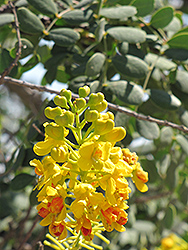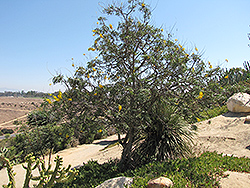Fri & Sat 8am - 8pm
Sun 8am - 7pm
Anytown, USA 12345
fax: 261.787.0463
e-mail: info@successgc.com


Plant Finder

Height: 15 feet
Spread: 15 feet
Sunlight:
![]()
![]()
Hardiness Zone: 9b
Other Names: Spiny Holdback, Peruvian Carob, syn. Tara spinosa
Description:
This large tropical shrub or small tree produces spectacular, long lasting, upright racemes of yellow and red flowers in summer, followed by attractive seed pods; bark is very thorny; easy to grow and adaptable, makes a good hedge plant
Ornamental Features
Tara features showy racemes of fragrant yellow flowers with red centers rising above the foliage from early to mid summer. It has attractive grayish green evergreen foliage which emerges light green in spring. The small oval bipinnately compound leaves are highly ornamental and remain grayish green throughout the winter. The fruits are showy brick red pods with a rose blush and which fade to tan over time, which are carried in abundance from early to late fall. The spiny bark and dark brown branches add an interesting dimension to the landscape.
Landscape Attributes
Tara is an open multi-stemmed evergreen tropical plant with an upright spreading habit of growth. Its average texture blends into the landscape, but can be balanced by one or two finer or coarser trees or shrubs for an effective composition.
This is a relatively low maintenance tropical plant, and should only be pruned after flowering to avoid removing any of the current season's flowers. It is a good choice for attracting bees, butterflies and hummingbirds to your yard. Gardeners should be aware of the following characteristic(s) that may warrant special consideration;
- Spiny
Tara is recommended for the following landscape applications;
- Accent
- Mass Planting
- Hedges/Screening
- General Garden Use
- Naturalizing And Woodland Gardens
- Container Planting
Planting & Growing
This plant is native to the tropics and prefers growing in moist environments with evenly warm conditions all year round. In our climate, it is usually grown as an outdoor annual in the garden or in a container. If you want it to survive the winter, it can be brought in to the house and provided with special care, and then returned to the garden the following season. In its preferred tropical habitat, as a shrub it can grow to be around 15 feet tall at maturity, with a spread of 15 feet. However, when grown as an annual or when overwintered indoors, it can be expected to perform quite differently, and its exact height and spread will depend on many factors; you may wish to consult with our experts as to how it might perform in your specific application and growing conditions.
This tropical plant does best in full sun to partial shade. It is very adaptable to both dry and moist growing conditions, but will not tolerate any standing water. It is considered to be drought-tolerant, and thus makes an ideal choice for xeriscaping or the moisture-conserving landscape. It is not particular as to soil pH, but grows best in rich soils. It is somewhat tolerant of urban pollution. This species is not originally from North America, and parts of it are known to be toxic to humans and animals, so care should be exercised in planting it around children and pets.
Tara makes a fine choice for the outdoor landscape, but it is also well-suited for use in outdoor pots and containers. Its large size and upright habit of growth lend it for use as a solitary accent, or in a composition surrounded by smaller plants around the base and those that spill over the edges. It is even sizeable enough that it can be grown alone in a suitable container. Note that when grown in a container, it may not perform exactly as indicated on the tag - this is to be expected. Also note that when growing plants in outdoor containers and baskets, they may require more frequent waterings than they would in the yard or garden.
-- THIS IS A TROPICAL PLANT AND SHOULD NOT BE EXPECTED TO SURVIVE THE WINTER OUTDOORS IN OUR CLIMATE --

